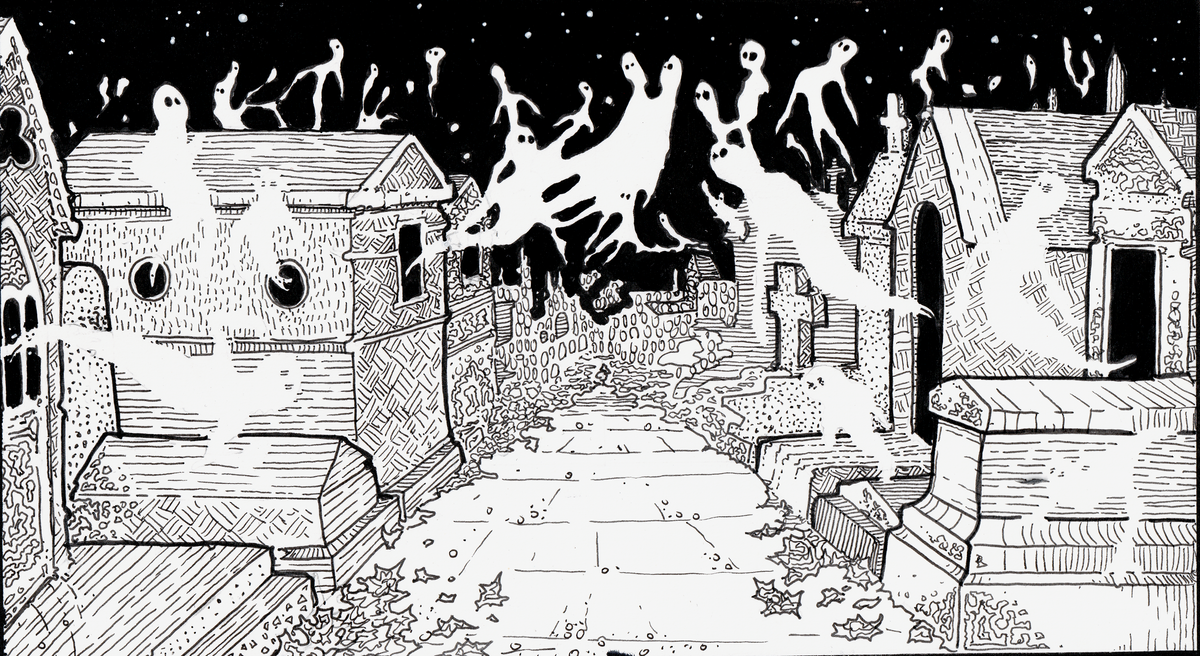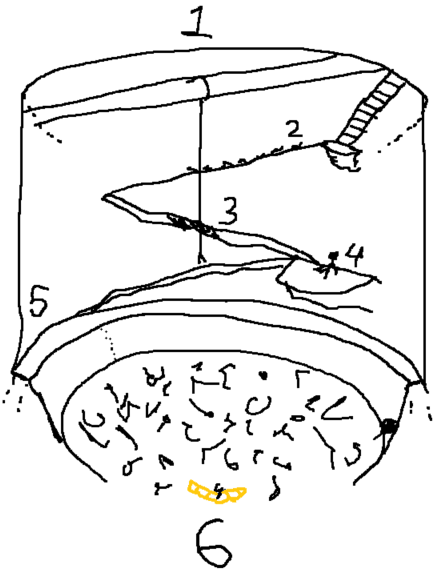October 2025 - The Most Spookiful Time of the Year

The last vestiges of summer are leaving the northern hemisphere, and pumpkin season is starting to get going, so the Carousing Collective is once again here to bring you the best in RPG blogging for you to read on your ever-shortening grey days. For those of you in the southern hemisphere—beach reads?
Roll to Carouse!
- Lighten your coin purse at the Projects Pavilion.
- Pilfer ideas from the Blog Bazaar.
- Sample the delights of the Gameable Gallery.
- Hear the raving of Reviewers Row.
- Stroll the Columnists Colonnade.
- Languish in the Opinion Oubliette.
Projects Pavilion ⤴
- Orestruck by Amanda P.
Amanda released Orestruck, her much-anticipated follow-up to Tannic. I haven't yet had a chance to give it a read, but I have high expectations! - Rowan H.
Blog Bazaar ⤴
- More Erroneous Pictures of Whales by Benign Brown Beast
Like them or not (I don’t), LLMs are here to stay. This post responds to the use of AI on Project Gutenberg with a level of granularity, specificity and lucidity that we will all need to sculpt our institutions to work responsibly in an AI inflected environment. - Zak H. - So Very Many Updates About the Hill Cantons by Chris Kutalik
Chris is back! Posts to the Hill Cantons blog have been infrequent since before I got into the OSR, but Chris published six posts in September, including a big update on the various Hill Cantons-related projects that are underway. Definitely give all his recent posts a look, and if you're unfamiliar with the Hill Cantons project, well here's a rabbit hole to get lost in for a while! - Rowan H. - How Do You Handle the "Inside" of a Hex? (George Lucas Special Edition) by Dwiz
Dwiz re-writes an old post of theirs for clarity, and plenty of people already liked the original. The discussions surrounding the purpose and application of Hexes and Crawls can refer to seperate, distinct styles of play, which Dwiz lays out here. - Farmer Gadda - Murder Party: elaborate LARPing, Soirées-Enquête, Jubensha, and Neysa McMein by Wobbu Palooza
This is an amazing column about murder games that I came across, detailing high society LARP-ish murder parties from the 1930s. Really fascinating. - Patchwork Paladin - Mythic Feasts by Chris McDowall
A Certified Chris McDowall Banger. It's been a real pleasure watching Mythic Bastionland be extended and embroidered since release. This post in particular is easily pinched for your elfgame of choice. - Zak H. - A Hex Map For Middle Earth by Josh McCrowell
Josh has begun keying one hex per day of a 12-mile Middle Earth hex map from Idraluna Archives. I also reread The Lord of the Rings this year—albeit for the first time since I was a teenager—and I've thoroughly enjoyed each entry in this series! It's an incredible project, and I hope Josh keeps at it. - Rowan H. - Character Studies by Rowan H.
A wonderful deep dive into different styles of making compact and memorable NPCs. Good if you're a writer but equally good when preparing a session. - Patchwork Paladin - Daggerdark? Shadowheart? Daggers in the Shadow? by Blazer's Ramblings
Can you combine Shadowdark and Daggerheart? Do you want to is one question, how is another, which this post attempts to answer by giving two Daggerheart environments ("the shadowed dark"). Whether or not the environments succeed in their aims (and whether or not they are environments or mini campaign frames), this blog points the ways forward in terms of rules packages or hacks that can be added to Daggerheart to achieve different effects. A development to watch. - Patchwork Paladin - The Most Important Skill as a GM by Nate Whittington
The most important skill a GM can have is often taught wrong by the bigger rpgs like D&D. This post by Grinning Rat has some great practical advice. - Clayton - What Do Critics Owe Us? by Nova
Nova of Playful Void discusses the qualities she considers while writing reviews and argues that critics owe their audiences transparency about their goals. It's a great piece, and it's inspired me to write a post about my own point of view before publishing my next review. - Rowan H. - WHY MEGADUNGEONS? A Campaign Structure for Modern Lives by Warren D
Warren makes a lot of good points why megadungeons have been historically, and still are, good examples of a player interaction focused campaign structure. - Tobias - Appendix N Blog Bandwagon
The latest blog bandwagon garnered over 69 entries, including Carousing Collective members Elizabeth, Elmcat, Farmer Gadda, Liz, Markus, Rowan, Sandro, and Zak!
Gameable Gallery ⤴
A Trio of Magic Items
by Markus M
The Wings of Hubris
A set of wings made from feathers and lightweight wood, attached to a leather harness. They allow the wearer to fly short distances, but the imperfect magic holding it together will heat up the wings when used.
This means that there is a 1-in-6 chance that the wax holding feathers and wood together will melt, and the wearer will fall from the air. This increases to a 2-in-6 chance if the wings are used twice in quick succession, and so forth.
The magic ensures that the structure of the wings themselves will not be damaged by such a fall, and the feathers will recover after 24 hours.
The Doomscroll
An enchanted scroll in a forgotten language. Anyone who attempts it can intuitively recite the words without knowing their meaning. The scroll is incredibly long, depending on the speakers cadence, it will take 1 to 6 days to read the whole scroll aloud.
Legend says that if someone were to recite the scroll from beginning to end, uninterrupted, the world will end.
The scroll feels vaguely cold to the touch, and is impervious to damage.
The Zombie Key
An eternally damp, rusty key. It has lichen growing on it. The key can be used to lock any door, such that no key may open it, though the lock will not appear broken. It cannot be used to unlock anything.
Reviewers Row ⤴
Ave Nox Mini Review
by Clayton Notestine
This system-neutral megadungeon by Alex Coggon and Charles Furuson-Avery is as decadent as its hedonistic city of Solis. The color in particular is a stand out with its warm sunny yellows and cool, corpse-y blues. The art is excellent. Evocative and charged. Often frozen a millisecond before disaster. The challenge is that there's so much of it, and the linear structure, cramped layout, and longer prose makes the reading experience claustrophobic.
Isle of Hex Mini Review
by Clayton Notestine
This island sandbox by Diogo Barros is all about character. Weird ones. If you've ever stumbled into one of those towns in Appalachia or Wales, the kind time and reality has forgotten to keep an eye on, you probably know what kind of island this one is. It's got bog bodies, aliens, and machine elves—but worst of all—it has weird neighbors. Check this zine out. It ended up being too weird for the Ennies judges, which means its probably a masterpiece for some.
Columnists Colonnade ⤴
Dungeons in Dialogue
by Taylor B.
Intro
A habit I've grown to love across several different projects recently has been writing in conversation with other artists' work. In some ways all art we create is part of this conversation - we all have a big soup of influences (from life and other artists) swirling around inside our brains that we spoon from for our own works - but there's a specific kind of joy I get from writing more reactively to other folks in the tabletop space. It's exciting for me to try and get on someone's level, match their tone and energy, and cut through to the spirit of their work so I might bring it into my own.
Today, I'd like to document a portion of this process. Let's dig in.
Finding the Heart
My goal is to write a dungeon housing one of Markus' magic items, seen above in the Gameable section. The Wings of Hubris call out to me here, so I'm going to work with those. My first step is going to be reading through the text with an eye for interesting images, turns of phrases, and noteworthy details, ultimately looking for any kind of core idea or inspiration to use as my foundation.

The item itself - a pair of wings that get more failure-prone the more you fly - is a pretty straightforward translation of the Icarus myth. The specificity of hubris in the name calls to mind a few extra-prideful spots to hide these bad boys: a ruined battlefield (corpse loot?), a gladiatorial arena (as a prize?), an emperor's tomb (treasure? in honor or mockery?). Of those, the tomb is the least interesting to me. For one, I feel the wings by nature want to be found in open air, but for two the fact that they always have a chance to fail on use gives me pause on associating them with a powerful ruler. That innate 1-in-6 fuck-you roll is too finicky for this to be, like, the prominent treasure at the end of a gauntlet or a rich person's prized trinket. Instead it's giving something closer to a prototype for experimentation, or a tool used only in desperation (or both, as in the original myth).
What else? Well, Markus adds a detail I really like at the end: the wings restore themselves automatically after failure, no matter how far or how hard the wearer falls. My first reaction to this was picturing the pristine, unbroken wings juxtaposed with the broken body of their last user, which is... pretty gruesome. That by itself is enough to work with, but I'd like to get a bit bigger with it in probably the simplest way possible: instead of one dead guy, why not twenty? What if a whole bunch of people were driven to use these wings only to die in the process? What could get them to that point? I keep going back to that idea of desperation, the way the myth's wings are a tool for escape, and that solidifies the image for me.
Generally when I'm working on something, I write a "core image" that serves as a touchstone I can always go back to when I take a break from writing and need to get back into the right headspace. I'll do that here using the points discussed above.
Splintered bodies heaped at the bottom of a deep pit, all in varying states of decay. The red stone walls near the bottom bear pale scratch marks ending around six feet up. At the top of the pile, the least putrified corpse wears a pristine set of wings, shining dimly in low light.
Now to write the rest of the owl! Just gonna be using pretty standard dungeon design principles here. For a little extra sauce, I've been playing Bennett Foddy's latest rage bait game Baby Steps recently, a game of tricky climbing where failure leads more to morale damage than anything physical. I'm going to try and incorporate a little bit of that energy into the final product. Enjoy!
Dungeon: From Dust to Dust
There's a wound in the earth, speared through the crown of a red rock mesa. The smell (sun-rot, sweat, stale blood) drives away all but the vultures.

- Stringy wooden planks span the hole. The dust coverage says they're recent. Knotted rope hangs from a nail driven into the bridge's center, dropping ramrod straight down the earth's gullet.
- The rope stops at a height just below area 4. It's frayed at the end, strands like antennae probing the dark below. - A deathly thin path snakes around the pit's edge, too tight to move without your back pressed to the wall. Small anthills stake their claim here, wedged into large cracks in the wall.
- They're rockbiter ants, fiercely territorial, and quickly swarm anyone passing through with jaws made to crunch through hard stone. - The path widens slightly. One ten-foot section juts at a lower angle to the rest of the path, hairline cracks running through where it connects to the wall of the pit.
- If one person puts weight on this section to cross, it shakes and dislodges a few pieces of stone. If used again, it gives up the ghost; the entire ten-foot section crumbles and falls to the bodies below. - A corpse leans against the wall on a small outcropping, eyes hidden under two gold coins. He wears rags and tattoos; no shoes. Rope tied around his waist extends a heavily-frayed tendril to his left side, where he clutches something tight.
- He's holding a climbing piton covered in reddish brown dust.
- Inspection shows his right leg is broken, alongside signs of severe dehydration. - A small ledge runs the circumference of the hole, twenty feet up from the bottom. Smooth, steep slope flows down on all sides from the ledge to the bottom.
- One might slide down the slope without major injury, but it's too steep to climb without help.
- Finger-sized holes, clearly man-made, dot a line on the northern slope from the pit's bottom to the ledge. - Splintered bodies heaped at the bottom, all in varying states of decay. The red stone walls bear pale scratch marks ending around six feet up. At the top of the pile, the least putrefied corpse wears a pristine set of wings, shining dimly in low light. Sounds of grinding machinery emanate from the southern edge.
- The corpse is wearing the Wings of Hubris, text not reproduced here lol
- A man-made hole, barely big enough for one person to crawl through, cuts deeper underground. Within: slow grinding, the scent of oil, occasional belching smoke. At noon the sun's light leaks through the hole, promising surface and freedom. A lie.
- In the center, signs of impact from above have caused the topmost bodies to crater inward.
- Below area 4, the claw end of a hammer sticks from the forehead of an open-mouthed corpse.
Final Thoughts
I like the way this turned out! The process was a bit over-explained (it's not like it takes a PhD to look at something Icarus inspired to say "what if the user was escaping from somewhere?"), but I hope the path I took to get here makes sense. More importantly, I hope this encourages you to riff on something that inspires you. Add on to a world you like, think about blanks you can fill in, write a backstory for that weird item you saw on a random table one time. You might just be one voice in a larger conversation, but your voice is still important. Take care!
Opinion Oubliette ⤴
Swing For the Fences
by Rowan H
On a recent episode of Between Two Cairns, Brad, Yochai, and Sam answered a question about whether writing an adventure for a setting that's not generic/Tolkienesque/D&D-like decreases marketability. Brad pointed out that more modular adventures might yield a better adoption rate, while acknowledging that uniqueness can also be a selling point. And Yochai said, "It should either be better than whatever you're copying or it should be original, but either way it should be good." These are great responses, but I take issue with the premise of the question.
If you look at the most commercially successful games in our corner of the hobby, you'll find some that hew closely to traditional D&D fantasy, but you'll also find others that carve their own distinct niches: Ultraviolet Grasslands, Bastionland, and MÖRK BORG come to mind. I wonder, though: why worry about marketability in the first place? Very few people earn much money by designing role-playing games, and fewer still make a career out of it. Why allow your assumptions about other people's preferences to stifle your creativity?
Just make the thing that excites you and leave marketability to the professionals. Even more importantly, have ambition and swing for the fences. Capitalist incentives for approachability and marketability too often result in banal, unimaginative media. Why bow to those pressures if you don't stand to benefit commercially in the first place?
I feel similarly about the obsession with compatibility among certain OSR adherents. I understand the appeal of having access to a wealth of broadly compatible, modular products, but when I see a certain type of grognard define an OSR game as one that can be used to run Keep on the Borderlands with minimal conversion, my reaction is why the hell would I want to do that?
Nostalgic recreation of '70s and '80s adventure gaming is a totally valid way to engage with the OSR, but it's not the only valid way. I was born in the '90s. I'm not here for nostalgia and tradition. I don't care if adventure gaming has had ability scores and hit points, elves and goblins, since its inception. I'm here for the principles, and I want to what happens when we push them in unexpected directions.
All this to say, we already have the old stuff, so make something new, and commit to your vision, haters and gatekeepers be damned.
